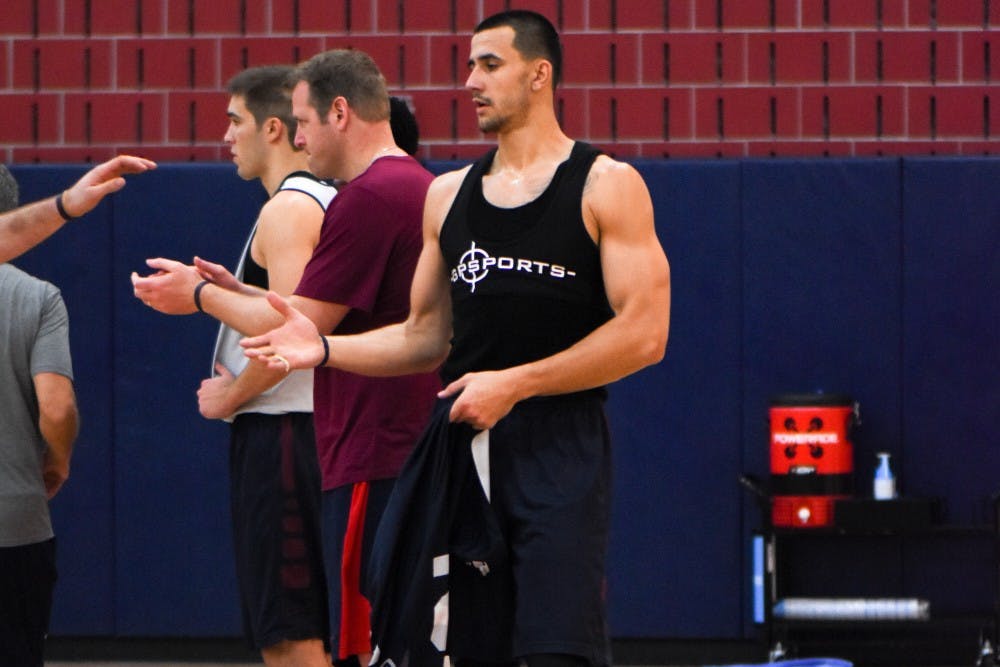
During practice, sophomore Mike Auger and his teammates wear vests from GPSports underneath their practice jerseys.
Credit: Ilana Wurman , Ilana Wurman, Ilana WurmanCoach Steve Donahue is not the only new fixture at the Palestra these days for Penn men’s basketball.
Since the dawn of the official 2015-16 season, the Quakers have welcomed another newcomer into their practices, this one a little more technologically advanced than the new man at the helm. Starting in early October, the team has been wearing GPS vests made by GPSport under their practice jerseys.
“The GPS monitors really themselves aren’t anything new. They’ve been in the sports performance industry for a while,” said Eric Laudano, Penn’s associate athletic director for sports performance and head athletic trainer. “They are new to Penn and new to Penn basketball.”
At first glance, it might seem confusing why an athletic team would be using the same technology that us directionally challenged folk use when driving. But the GPS element of the vests, which closely resemble a slimmed down and cropped Kevlar vest, is quite straightforward.
When players wear the vests, the GPS technology is able to keep track of their position on the court at all times during practice, how many miles a player logs during a two-hour stretch of training and a player’s heart rate all the while. These numbers are made available to the coaching staff in real time, making it possible to closely monitor every man on the court and address any concerns of fatigue the instant they may arise.
“As a coach, it really just gives you an opportunity to really just plan your practice and help with the development of guys, because you know instead of guessing that you know what, we went hard yesterday, let’s go easy today,” Donahue said.
Coaches are able to get a sense of a player’s exertion based on the data collected from the GPS vests rather than how rosy their cheeks are after training or how winded they look when walking off the court after practice.
“What Coach Donahue has done is really embrace the whole global umbrella of sports performance,” Laudano said. “What that really does is help him assist in similar things in fatigue in practice or levels of fatigue that happen in certain times of the year.”
Indeed, hard numbers allow Donahue and the rest of his staff to write smarter practices during the season — something that is especially crucial during the grueling stretch of consecutive Ivy games on the weekends in January and February.
When it came down to wearing the vests for the first time, the members of the team played with tempered enthusiasm, complaining about the vests fitting uncomfortably. Now, four weeks later, these complaints are absent from the team’s practices at the Palestra and Rockwell Gym.
“I think the guys are excited about it,” Donahue said. “Everybody gets excited about it if you feel that we’re trying to make them better and really doing it in a scientific way, not just guessing.”
Given that the team only started using the technology in early October, the sample size of data is still relatively small. Additionally, this season marks the first time that Donahue has implemented this kind of sports performance analytics into the training of any team he has coached over the course of his career. Thus, it is just as much a learning process for the coaches as it is for the players.
“I may not be great at figuring it out now, but after another year of it I can really judge exactly what I need to do each day preparing for that weekend’s games,” Donahue said.
Moving forward, Donahue wants to find a use for the data beyond just planning smarter practices. He envisions a way to tap into the competitive spirit of his players and use the data collection as a motivational tool.
“We’re going to have our big screen 60-inch monitor down there [courtside] that [the players] can actually peek over and see where they’re at,” Donahue said. “I want them to say, ‘You know what, you didn’t reach your target heart rate 70 or 80 percent of the time. So look at your teammates.’”
If this mentality takes with the Red and Blue’s roster, Donahue will be able to instill a layer of accountability into his training regimen. This falls in line nicely with the each of the five core values Donahue picked for his team to embody in his inaugural season at the helm: passion, gratitude, unity, compete and humility.
Whether or not all of these new bells and whistles will translate into more tallies in the win column for the Red and Blue remains to be seen — the first game of the season against Robert Morris still awaits on Friday.
But if Donahue’s optimism about the new technology is any indication of what this season holds for the Quakers, this sports performance technology might be the thing that helps lift Penn basketball from its latest slump.
The Daily Pennsylvanian is an independent, student-run newspaper. Please consider making a donation to support the coverage that shapes the University. Your generosity ensures a future of strong journalism at Penn.
DonatePlease note All comments are eligible for publication in The Daily Pennsylvanian.





